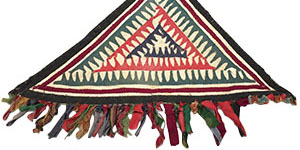
Historically, the primary role of patchwork in Central Asia has been that of a protective charm or amulet used by brides, new mothers, and children to guard against sorcery, sickness, and malevolent spirits. In both Turkic nomadic culture and that of the sedentary Iranian world, traditions containing mystical elements of pre-Islamic beliefs, Zoroastrianism, and Sufism represent deep-seated cultural and religious values. In times of difficulty and uncertainty, whether from illness, war, or the inexplicable, people sought answers through a variety of rituals that employed amulets and talismans.
In the Central Asian Republics, people made amulets (tumar or doga) in the shape of a triangle using felt, cloth, or silver and used these talismans in a variety of settings.1 The nomadic population attached them to clothing and animal trappings in order to appease supernatural elements, protect against harm, and keep the mystical forces of nature in harmony. The tumar came in a variety of sizes, were frequently embroidered or embellished, and often contained a few grains of salt or a verse from the Qur’an.
The triangle was also used in multiple combinations, forming large-scale patchwork hangings and bedcovers. In addition to talismanic functions, they provided rich architectural furnishings in both nomadic and sedentary homes, merging aesthetic and cultural traditions while enhancing the social status of the family.